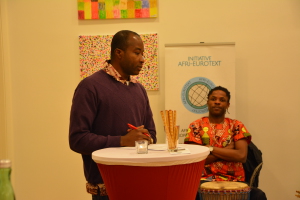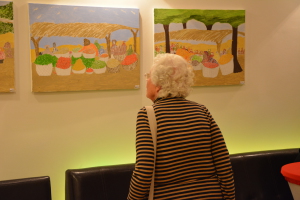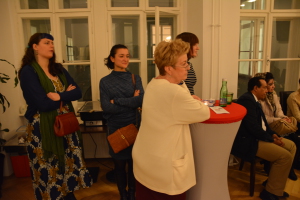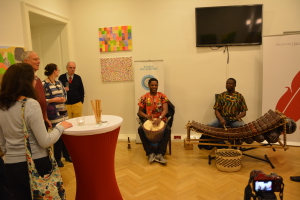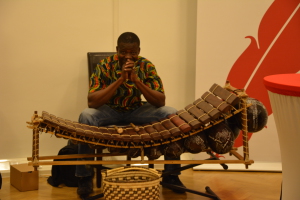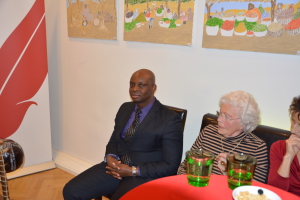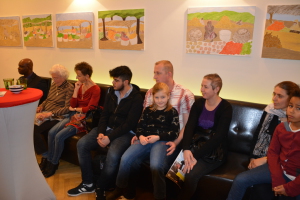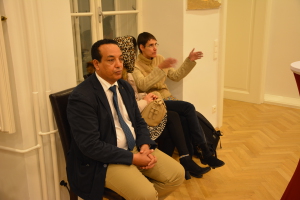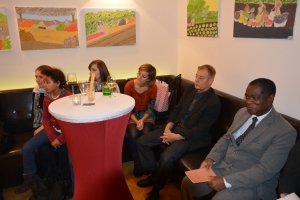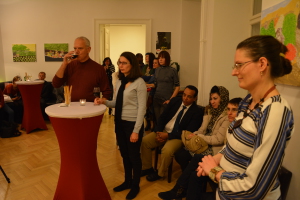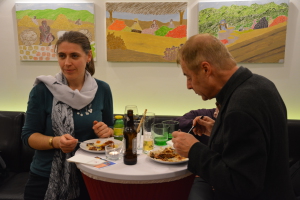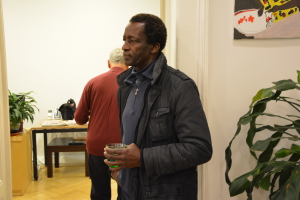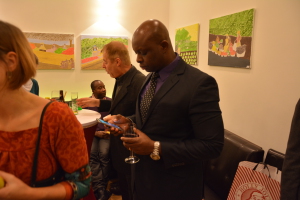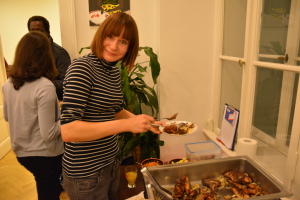PROJECT FOCUS: CULTURAL DIVERSITY
ART exhibition: African market women as driving forces for the advancement of Africa
AFRI EUROTEXT wants in this exhibition or through this exhibition first to set a tribute to these women (not only in Africa but also in Asia, Central and South America, etc.), who are facing their daily challenges with heart, courage and intelligence . Secondly, AFRIEUROTEXT would like to send a signal to the visibility of this structurally made invisible subjects. AFRIEUROTEXT is convinced that art is a part of the intellectual, scientific and profane discourse about our world.
The exhibition entitled, African market women as driving forces for the advancement of Africa, is the Abschlußveransstaltung of the AFRI EUROTEXT project "intercultural learning and people aware global asymmetries" to the focus of the project "cultural diversity" for the 2015 year activity. The theme of "African market driving forces for the advancement of African women" is capitalized in AFRI EUROTEXT. The opening of the exhibition took place on Wednesday, 25. November 2015 at 19:00 at the Press Club Concordia, Bankgasse 8, Vienna 1010 instead. The opening was the Europe and Africa-wide known xylophone expert who has upgraded the Vernissage by his stunning performance of xylophone, musical by frenetic sounds of Xylofons by Mamadou Diabaté. All guests have dared to dance steps. The exhibition at the same time took the visitors to the exhibition with on a journey into the diverse culinary world of Africa: fried plantains with spicy grilled freshwater fish were offered to the enjoyment.
Exhibition objects or subjects are painted pictures of market women and marketplace scenes painted on white canvas with acrylic paints. Colors that appear each other on these screens in a Synaesthetic dialogue and which make visible and noticeable virtue of market women. The pictures bear labels that are reminiscent of places in Africa. You make attention to people who are traveling and using on-board means attempting to organise a world beyond fatalism. The pictures of the exhibition of course raise issues: political, social and cultural questions, questions of local and global power relations.
"I see Assukuma, offered their vegetables on bare ground in the market square of Benjang,
and with the proceeds of a many-headed family ernährend and grooming.
I hear yet the entreating voices of young and adult women,
you challenged the darkness of the stops in the tropical forest at midnight,
armed with a flashlight chant:
Banana, banana, banana…
Peanuts, peanuts, peanuts…
Cassava pieces, pieces of manioc, cassava pieces, five pieces to 100 francs cfa…"
(Excerpt from the novel hard tropical by Daniel R. Bitouh in formation)
However, these women make a laudable social contribution. A post which, structurally due – be mostly invisible is made and remains undocumented. "Market women" is an all-encompassing term for an in fact heterogeneous and complex reality of rural and urban communities in the countries of Africa. The exhibition would like to counter the stereotypical representation of market women as unsightly "objects" with images, which recognise women in their role as Alltagsheldinnnen. In reply the artistic works not with maintaining homogenizing representations of the market woman, but draw a tissue of girls, young and old women with their own stories: there are married and unmarried women, widows, orphans, single parent. There are women from different socio-psychological or socio-political reasons not the school or partial visit (could). And there are those women who feed their large families, send their children to school and build this road of hope. This is only one dimension of their diverse contribution to the development of the country or to peace.
The economic organization forms are not covered in the statistics of the unilateral logic of the international financial institutions (IMF, OECD, and banks), representing this market women. Anachronistic, it is repeated that the contribution of the afya European continent to the overall global economy is only 2% to 0%. Such statistics will be passed on the fact, that only the value is quoted by gold, diamond, nickel, copper, coffee, cocoa or bananas on the exchanges but not the 7 kilometers, which every day under the scorching sun and back must discard a market woman walking in a rural area, to achieve her cassava field.
The exhibition of African market women as driving forces for the advancement of Africa is the result of a year-long work by Daniel Romuald Bitouh and Nicole Binder. The pictures of the exhibition are unique items that are offered for sale. (see Presseclub Concordia, Bankgasse 8, 1010 Vienna.) Tel. 0043 153385730)
The AFRI-EUROTEXT Club would like to thank
-at the press CLUB CONCORDIA (main cooperation partner) and wife Dr. Astrid Zimmermann, General Secretary of the Press Club Concordia
-at the May 7 science and research promotion
-in the Arts Division of the Federal Chancellery
-In the Afro-Asiatic supermarket PROSI
-When the employees of the organisation of the AFRI EUROTEXT project
for the kinds of support.
AFRI EUROTEXT thanked also the numerous visitors for the evening, which has great joy all those involved.
The annual end of January 2016 Finissage will be at least as great. The exact date that will be announced soon on the website afrieurotext.at. Until then, the exhibition images are of course still in the premises of the Press Club to visit Concordia.
NB: All projects, texts, and images of the initiative AFRI EUROTEXT are copyright protected.
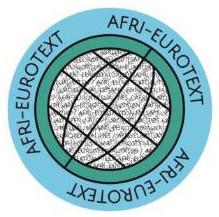
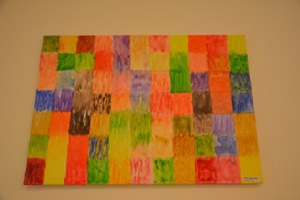
![WP_20151125_14_08_23_Pro[1]](http://www.afrieurotext.at/wp-content/uploads/2015/06/WP_20151125_14_08_23_Pro1-300x168.jpg)
![WP_20151125_14_07_48_Pro[1]](http://www.afrieurotext.at/wp-content/uploads/2015/06/WP_20151125_14_07_48_Pro1-300x168.jpg)
![WP_20151125_14_07_04_Pro[1]](http://www.afrieurotext.at/wp-content/uploads/2015/06/WP_20151125_14_07_04_Pro1-300x168.jpg)
![WP_20151125_14_05_27_Pro[1]](http://www.afrieurotext.at/wp-content/uploads/2015/06/WP_20151125_14_05_27_Pro1-300x168.jpg)
![WP_20151125_14_04_27_Pro[1]](http://www.afrieurotext.at/wp-content/uploads/2015/06/WP_20151125_14_04_27_Pro1-300x168.jpg)
![WP_20151125_14_03_12_Pro[1]](http://www.afrieurotext.at/wp-content/uploads/2015/06/WP_20151125_14_03_12_Pro1-300x168.jpg)
